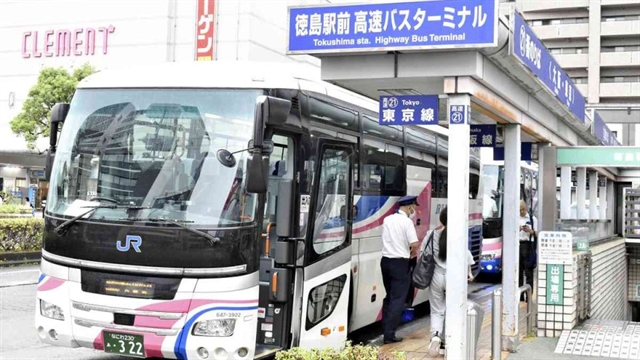 World
World


|
| An express bus stops at Tokushima Station in Tokushima in June 2024. PHOTO: THE YOMIURI SHIMBUN |
TOKYO – The Land, Infrastructure, Transport and Tourism Ministry will start a demonstration experiment using digital technology to eliminate “transportation blank areas,” where it is difficult to use public transportation. The ministry aims to improve convenience by using AI analysis to arrange reservation-based buses for the elderly to use for hospital visits and secure cabs for tourists during trips.
They aim to put the system to practical use for nationwide rollout by around 2030.
The ministry announced concrete plans last month. It plans to conduct about 20 experiments in this fiscal year.
The experiment to be conducted in Tokushima aims to improve the operation of reservation-based buses used by patients to return home from hospitals. Fujitsu Ltd. will create a system that predicts how long it will take for patients to receive medical care and finish paying their bills.
The reservation system of Tokushima Prefectural Central Hospital will be linked with the bus dispatch system operated by a taxi association in the prefecture. If the system can predict with a high degree of accuracy the time patients would be able to board the bus, it will be possible to dispatch a bus to take them home just before they are supposed to leave the hospital, preventing long waiting times.
Asahikawa Airport in Hokkaido aims to develop a system that enables smooth travel from the airport to tourist attractions. Airlines will share information on the number of arriving passengers and delays to arriving flights with local bus and cab companies to adjust arrival and departure times at the airport. That will also make it possible to have a suitable number of cabs waiting at the airport. Jorudan Co., a major transfer information search software company in Tokyo, will develop the system.
In recent years, railroad and bus services in Japan have been reduced due to a decline in the number of passengers. In depopulated areas, the elderly have been forced to refrain from visiting hospitals because they have no means of transportation. Some tourist destinations are unable to cope with the increased demand for public transportation caused by increasing numbers of foreign tourists and other visitors.
Ridesharing, in which individuals use their own cars to transport people for a fee, is gradually expanding as one solution, but, as with cabs, there is a shortage of drivers.
Last year, the ministry established a public-private partnership organization to address the transportation shortage and has been soliciting new initiatives to solve the problem. While it is difficult to solve the shortage of bus and cab drivers all at once, the ministry intends to use AI and other private-sector technologies to improve efficiency and cover the labor shortage. THE JAPAN NEWS/ANN